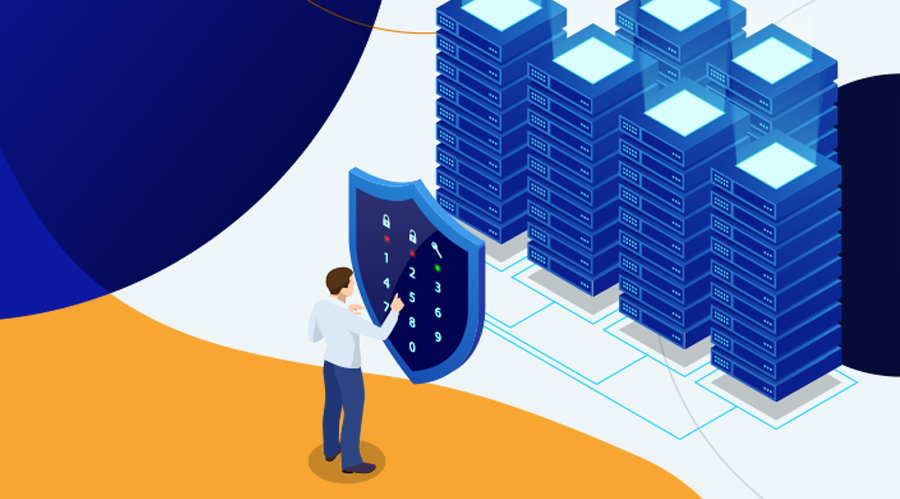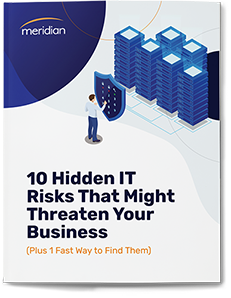
You may not be in the intelligence technology business, but it’s probably impossible to imagine your business without IT. Today, computing technology plays a vital role in the way you serve, work with, and communicate with your clients. Thanks to advances that have made technology more powerful yet less expensive, even the smallest practice can enjoy capabilities – in everything from marketing and sales, to delivery and fulfillment – that were once the sole domain of large enterprises.
But today’s big IT advantages can come with major risks. Your networks and systems serve as your silent partner in operations. Should they fail –and when they do, it’s usually without warning – you’re exposed not just to an IT problem, but to a potentially large business problem.
This brief eBook exposes 10 silent threats that might be quietly undermining your operations now – and proposes one quick, easy and FREE way to bring these threats under control, fast.

Not a problem! Enter your email below for a downloadable PDF version that you can read on your own time.
You want to run your businesses, not an IT department. While IT may not be top of mind, it should never be out of sight. Lack of vision into the true status of your technology, and the quality of your defenses against attack or failure, may leave your business vulnerable to disruption, legal consequences, and loss of revenue. By implementing regular monitoring and review procedures, however, you can anticipate challenges before they become problems, and take adequate measures to ensure the smooth conduct of your firm.
Smart businesses and wise managers protect their critical networks with redundancy: backup servers and routers that are designed to kick in should the main system goes down. But the contingency plan is only as good as the processes and practices behind them; should these be inoperative, your business will not maintain continuity in an emergency. To safeguard your business, analyze your network before disaster strikes to be sure that your contingency technologies – such as your backup designated router or alternate domain control – are online and ready for action.
There may be “ghosts” haunting your networks – inactive users or inactive computers that remain part of your system, even if they are no longer contributing to your productivity. While the threat may not be immediately obvious, defunct computers represent an expense you don’t need to carry. Worse, inactive users may reflect open accounts (perhaps of people who are no longer employed by your business) that could present security holes for unauthorized access. Run audits that show you what’s active or not, then the clean house – and close security loopholes – by burying the “dead” devices and accounts.
Despite high hopes for the “paperless” office, the reality is that businesses spend lots of money printing, faxing, copying, and scanning paper documents. Consider the math: paper plus toner plus maintenance plus employee time, etc. It’s possible to bring these printing costs under control, but the first step is to discover who prints what, how often, and why. By monitoring your multi-function printers, you can limit access to authorized users, discourage unnecessary or wasteful usage, and encourage less-expensive options – such as scan to email or scan to file directories – that save time and money.
Sensitive data demands special attention. In many businesses, the law obliges you to preserve client confidentiality – and demonstrate that you have processes in place to ensure compliance. The best way to prepare for a regulatory audit is to run regular compliance audits of your own that allow you to take corrective actions before your operation is called into account.
If you lost a significant chunk of your data right now, how much business would you lose as well? Too many businesses run without sufficient policies, plans, and procedures for backing up critical data essential to their ability to operate. If your business depends on manual procedures that are executed inconsistently, you’re exposed to unnecessary losses; it’s time to look for automated backup solutions that are always at work – even when employees might be forgetful.
Your password protections are only as strong as the passwords themselves. Having no passwords – or using obvious passwords such as “12345” – undermines the very protection you seek. Yet employees often fail to establish passwords or, when they do, frequently use ineffective ones. Review your passwords’ strength to identify weak spots any unauthorized user could punch through.
Your business isn’t limited to your own systems. Thanks to access to outside servers and systems, you can leverage potent tools like Gmail and Dropbox to communicate with customers, share files and more. While these cloud services increase your capabilities without busting your IT budget, it’s important to remember that every connection that reaches out from your network may open an opportunity for someone else to reach in. Protect your portals: run an external vulnerability scan that reveals every “backdoor” through which an intruder might break into your network.
On the one hand, new devices such as smart phones and tablets can increase employee productivity – and when employees use their own devices, save the company money. But this new “bring your own device” (BYOD) environment brings new headaches, too. These devices are easily lost and stolen. When they are, any information available to the device – including confidential practice and client data – may be vulnerable to illicit access. Yet fewer than 50% of businesses report the ability to use data encryption and/or remote data wiping to protect
their assets. Take stock of your data inventory: you need to share permissions reports that reveal which devices and users have access to which files and applications.
It’s common sense: you restrict crucial information — such as bank accounts and inventory access — to carefully designated employees. Yet many businesses have lost control of their network’s user-level access privileges, exposing vital company and client data to people without authorization. One of the first steps toward security is to be sure the right people have the right level of access to appropriate applications and data.
Effective March 1, 2010, Massachusetts law M.G.L. c. 93h imposed the most comprehensive confidentiality requirements yet for the safeguarding of “personal information” such as Social Security numbers, driver’s license numbers, and other means of individual identification. Among the requirements are these: Encryption of all transmitted records and files containing personal information that will travel across public networks, and encryption of all data containing personal information to be transmitted wirelessly; and encryption of all personal information stored on laptops or other portable devices. To ensure compliance, law firms should consider implementing practices that can:
We all depend on IT. Given the stakes, it’s important our confidence is well placed. Are you sure the technology you rely upon is adequately protected? In our experience, nine out of ten companies have undetected vulnerabilities that could lead to data disasters.
Take a moment to complete this quick self-analysis. If you cannot answer yes to every question, request our FREE network assessment to give yourself – and your business – the confidence you deserve.

888-289-2776
info@whymeridian.com
Meridian Imaging Solutions
1595 Spring Hill Rd, Suite 450
Vienna, VA 22182
© 2025 Meridian Imaging Solutions | Privacy Policy